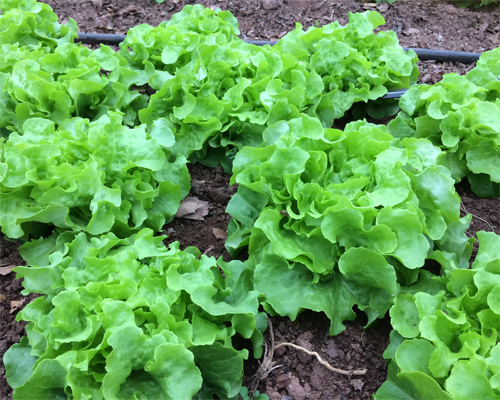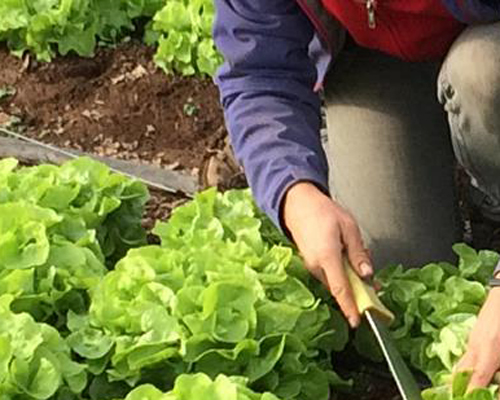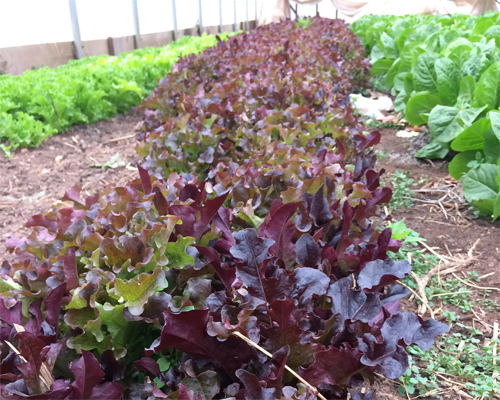
Fact Sheet FS1267
Ultra-Niche Crops are defined as exceptionally high-value crops that can provide a significant source of income to the farmer while using minimal land area.
Winter lettuce is a crop that is seeded or transplanted in a high tunnel or other protected structure after the traditional planting season. Winter lettuce planting takes place from late summer through the fall, and lettuce is harvested during the cooler months. Many types of lettuce are suitable for winter production in high tunnels, including Butterhead, Romaine, and baby leaf types. It is important to understand the growth needs of a winter lettuce crop, such as temperature requirements, and soil moisture. Producing winter lettuce in high tunnels provides a lower-input option to traditional heated greenhouse production. Growing winter lettuce in a high tunnel is a way to extend the season and increase revenue while maintaining your customer base through the winter months.
Marketing
Who will buy the crop? Winter lettuce can be sold anywhere consumers choose to purchase produce. Direct marketing to consumers is optimal because wholesale market prices are low due to competition from other regions, and because consumers are often willing to pay more for locally grown lettuce.
How suitable is this crop for agritourism? Winter lettuce is a good crop to offer at on-farm markets, winter Community Supported Agriculture programs, community farm markets, and agritourism operations.
How well does this crop withstand shipping? Winter lettuce is susceptible to freeze damage, and damage from rough handling during harvest, packing, and shipping. Proper handling, packaging, and temperature management are important to the overall quality of the product from the high tunnel to the display table.
Farmer's Tool Box
Essential Equipment/Supplies
- Refrigeration (if not PYO)
- High tunnel or other protective structure
- Planting trays (96, 128 or 200 cells per tray), if growing transplants
- Heated greenhouse, if growing transplants
- Rototiller
- Seed
- Wire hoops
- Row cover
- Hand hoes (weed control between beds)
- Harvest containers
- Harvest knives
What packaging should be used? Packaging for lettuce can vary, provided that it does not cause damage to the leaves. Moisture and cool, but not freezing temperatures should be maintained during display. Any bags or sleeves used should have holes in them to improve airflow.
Crop Requirements
Soil: pH range 6.0–6.5, well-drained to prevent root diseases. Crop rotation is important to reduce or avoid soil borne diseases such as Sclerotinia and Rhizoctonia.
Water: Continuous soil moisture is needed for seed germination if direct-seeding and for starting transplants. Drip irrigation is recommended, but irrigate only when needed. The water needs of lettuce plants are considerably less during the cooler months. Lettuce leaves should be kept as dry as possible to reduce the incidence of foliar disease such as gray mold, and lettuce drop.
Light: Daylight length and intensity can have an impact on the rate of lettuce growth. Lettuce plants can be maintained past their growth period in a high tunnel and harvested as needed for market.
Timeline for winter lettuce in New Jersey: Winter lettuce can be planted from September through October for multiple harvests. Seven- to ten-day seeding intervals are recommended when multiple harvest dates are desired. Harvest dates are dependent on the desired maturity of the crop at harvest and the temperatures during the growth period. If the crop exhibits rapid growth, harvesting earlier than expected might be needed to ensure proper airflow around the crop. Days to harvest can range from 60 to 80 days, depending on temperatures. Cooler soil temperatures will lengthen the time between planting and harvest.
Growing the Crop
How are lettuce plants started? There are a large number of seed companies selling varieties of lettuce seed. Choose varieties that are more cold tolerant; Bibb and Romaine lettuce types have grown well in recent variety trials1. Transplants can help shorten the time the space is used for growing winter lettuce, and may fit some planting schedules better than direct-seeding. Transplants can be started in a heated greenhouse and then hardened off prior to being planted. Utilizing transplants increases space efficiency and improves the crop survival rate during early growing stages. If direct-seeding, coated or pelletized seeds (seeds that are encased in a material that allows for a consistent-sized pellet) result in a more uniform planting.
How is this crop typically planted? Transplants can be planted by hand or with transplant equipment, if available. Plants should be placed just deep enough so that the transplant media is no longer visible. Winter lettuce should be irrigated after transplanting into the ground.
How is the soil prepared for planting? Soil temperatures must be over 32°F and less than 95°F to direct seed. Lettuce has a higher nutrient need than many other vegetable crops. Soil testing is necessary to understand available soil nutrients and organic matter content. Consult the Mid-Atlantic Commercial Vegetable Production Guide for Lettuce (PDF) for more detailed information.
What is the optimal number of plants per acre? Loose head lettuce plants should be planted with 10 to 12" between plants and rows. If direct-seeding is used, seeds should be planted no deeper than ¼". Baby leaf lettuces should be direct-seeded into close rows 4–6" apart.
What is the general care and maintenance of the crop during the winter season? Floating row covers can be used to protect the plants from temperature fluctuations. Row covers used inside a high tunnel add additional insulation to the crop. However, careful consideration should be given when using row cover, as this will reduce airflow around the crop and increase the chances of foliar disease. Row covers will also reduce light intensity.
Gray mold (Botrytis cinerea), lettuce drop (Sclerotinia), bottom rot (Rhizoctonia solani), damping-off (Pythium spp. and Rhizoctonia), and powdery mildew (Erysiphe cichoracearum) are the diseases most commonly encountered during high tunnel lettuce production.
How is harvesting performed? Winter lettuce can be harvested by hand using scissors or knives.
When is the lettuce harvested? Winter lettuce is harvested based on the desired size of the leaves or heads. Baby leaf lettuce can be harvested much sooner than head lettuce types, and multiple harvests may be possible depending on growing conditions.
What are the postharvest cooling and washing requirements? Lettuce quality will deteriorate quickly if not handled gently. After harvesting, winter lettuce should be precooled to 32°F and stored at 34°F with a target relative humidity of 90 to 95%. Continuous air circulation is recommended; storage containers should be stacked no more than two deep, when possible. Lettuce is ethylene sensitive, so do not store lettuce in rooms or near ethylene-producing crops such as apples. When proper temperature and relative humidity are achieved, lettuce can be stored for up to three weeks. Depending on the growing conditions and harvesting procedures lettuce may need to be washed prior to storage.
What is typical yield in lbs./A at optimal spacing? Yield is dependent on seed variety and spacing. A general estimate for baby leaf lettuce is one ounce of seed producing 16 pounds of leaf lettuce. A general estimate for loose head lettuce types at 10" spacing with 12" rows is about 1200 heads per 1000 square feet of growing space.
Considerations for Organic Production
Can winter lettuce be grown organically? Yes, lettuce can be grown organically during the cooler months. Traditional organic production practices apply to growing winter lettuce. Here are a few key points to consider:
- The cooler months can reduce weed and insect pressures, but weeding and scouting for insect pests should continue.
- Preventive strategies for dealing with diseases are important in reducing crop loss due to disease. Increasing air flow around the plants is important through plant spacing, managing row cover, and strategic harvesting.
Critical Considerations
- Sanitation of dropped leaves is important throughout harvest and between crops. Dropped leaves can serve as a source of disease between crops.
- Only purchase seeds from reliable sources, and select for disease resistance. Hot-water treatments can decrease seedborne diseases in lettuce. More information on hot-water treatment can be found at the Rutgers Sustainable Farming website.
- Crop rotation is an important strategy to prevent disease. A minimum of a three-year rotation is advised, but may be difficult to achieve if high tunnel space is limited.
References
- Winter Lettuce Variety Trial. Washington State University. 2005. agsyst.wsu.edu/winterlettucereport03.pdf (PDF)
Additional Information
For more information on this and other Ultra-Niche Crops please visit our website.
February 2017
Copyright © 2024 Rutgers, The State University of New Jersey. All rights reserved.
For more information: njaes.rutgers.edu.
Cooperating Agencies: Rutgers, The State University of New Jersey, U.S. Department of Agriculture, and Boards of County Commissioners. Rutgers Cooperative Extension, a unit of the Rutgers New Jersey Agricultural Experiment Station, is an equal opportunity program provider and employer.




 Project sponsored by the USDA-NIFA Beginner Farmer and Rancher Development Program.
Project sponsored by the USDA-NIFA Beginner Farmer and Rancher Development Program.